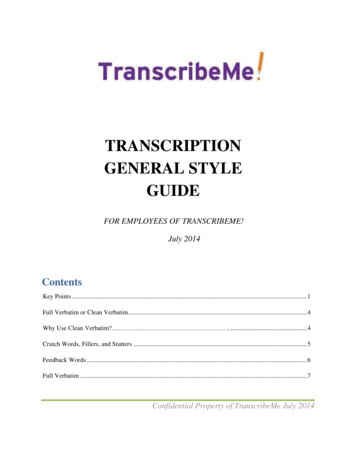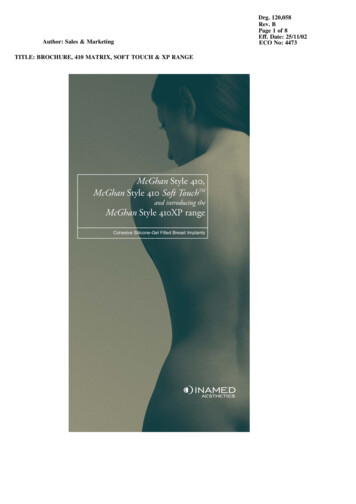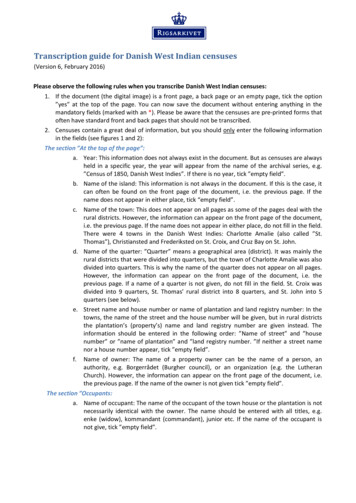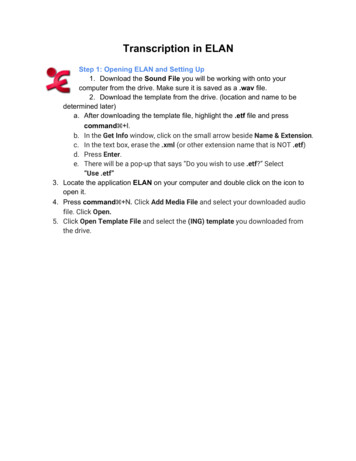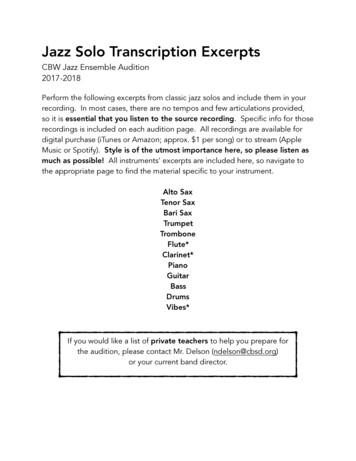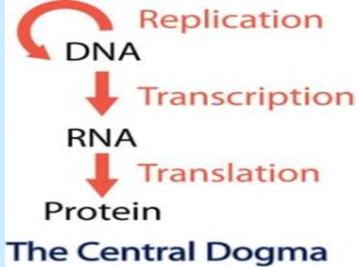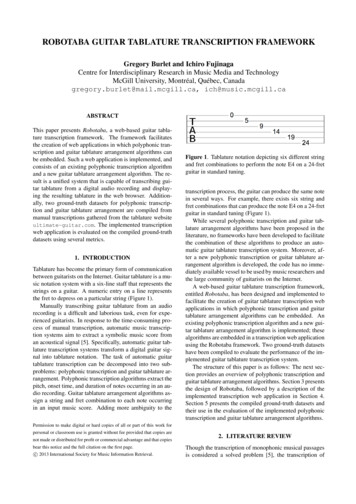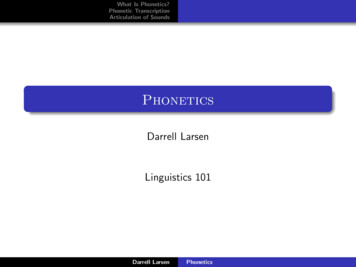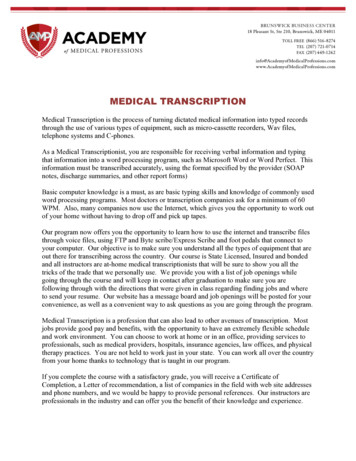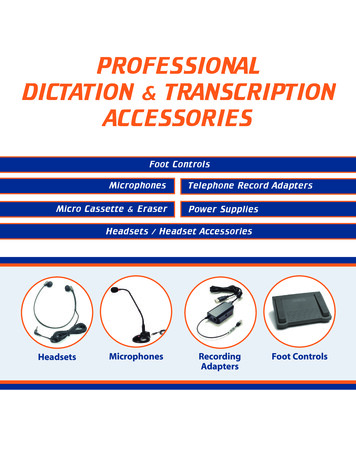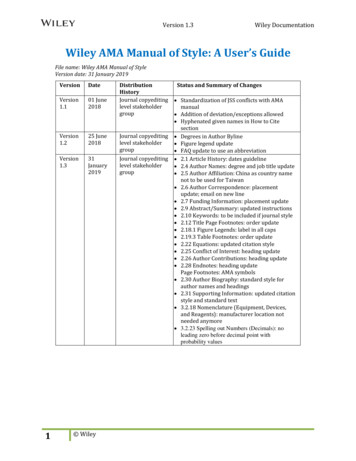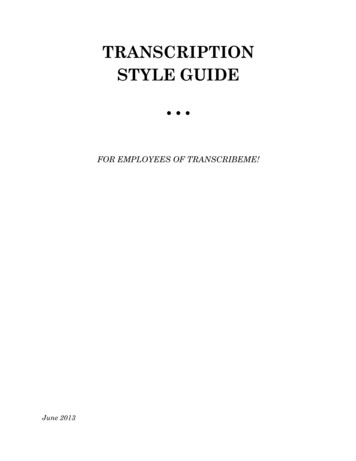
Transcription
TRANSCRIPTIONSTYLE GUIDE FOR EMPLOYEES OF TRANSCRIBEME!June 2013
ContentsIntroduction.1Full verbatim or clean verbatim.2Why do clients want recordings transcribed using clean verbatim?.2Crutch words, fillers and stutters.2Feedback words.3How to build mas.5Hyphens.6Apostrophes.6Colons and semicolons.7Quotation marks.8Dashes and ellipsis.9Transcription style guide.11False starts and interruptions.11Tagging non-verbal sounds and inaudible speech.12Numbers.14Common spelling and grammar errors.14General guidelines.15Useful resources.15
1IntroductionThis style guide is an attempt to provide guidelines for transcribers and QAs so that theymay more easily produce professional transcription documents which meet the needs ofTranscribeMe’s clients. Not all the points of style and grammar outlined in this documentshould be taken as absolute, unbending dictums; it is often personal taste that decideswhich rules are adopted and which are not.It should also be noted that this style guide is not intended to be an exhaustive or in anyway complete guide to English grammar and syntax as the rules outlined here have beenimplemented to meet the particular demands of transcription. Others have been included inresponse to the questions and concerns of TranscribeMe’s employees. Additionally, someclients may have specific requirements that are not in the style guide, and may evencontradict the style guide. Please check the guide on the workhub for client-specificrequirements.This style guide may use grammatical terms that you are unfamiliar with, such asindependent clause, dependent clause, conjunction etc. If you come across a term you areunfamiliar with, please refer to the glossary at the end of the style guide.Finally, if you have any concerns about the style guide, or feel that something has been leftout of the guide, please e-mail Greg at gregkantm@gmail.com.
2Full verbatim or clean verbatim?The default method for transcribing and reviewing documents in TranscribeMe is cleanverbatim. Transcribing clean verbatim will often require the transcriber or QA to use theirbest judgement to decide whether certain words or phrases should be omitted under cleanverbatim rules. Transcribing clean verbatim should not be a daunting task, however! Thissection will provide a clear explanation of why clean verbatim is used, and will includeexamples of the difference between full verbatim and clean verbatim.Why do clients want recordings transcribed using clean verbatim?Clean verbatim is an approach to transcribing which ensures that the transcription is clear,succinct and easy to read, while at the same time preserves essential information andmeaning. Clean verbatim means that erroneous speech – such as crutch words and fillers –is omitted from the final document. Typically, clean verbatim also means that non-formaltruncations of single words (e.g. ‘cause instead of because) are corrected to the properspelling. All possible exceptions to this rule will be specified in the style guide.Crutch words, fillers and stuttersThe most common features of speech altered by clean verbatim are stutters, filler wordsand crutch words. Crutch words and filler words are erroneous additions to a sentence thatdo not add meaning or coherency to a sentence. They are usually used when a speaker issearching for a thought or deciding how to properly express what he or she is trying to say.They may also be used to elicit feedback from another speaker or audience.Examples of crutch words and fillers can include the common um and uh, as well asphrases like you know, like, I mean, I guess and maybe. It is important that words like theseare properly identified as crutches or fillers, because these terms can obviously be used in away that is important to the meaning of a sentence. You can usually tell crutch words andfillers based on the context of their use and the way they are spoken. Consider the followingexample:Incorrect:And, I guess just maybe thinking of your other ideas and some of the, like, um,suggestions you made earlier.Correct:And thinking of your other ideas and some of the suggestions you made earlier Important: The word like can be deceptive. At times it may sound like it is being used as acrutch word when it is really being used to signify an approximation. For instance, ‘I was inbed for, like, two weeks’ is a sentence where like is being used as an approximation of timeand should not be omitted.
3Stutters should be easier to identify. A stutter is the unnecessary repetition of a word orsound and should always be omitted. However, please include words that are repeateddeliberately for emphasis. An example of this might be ‘The pizza was really, really good.’However, the sentence ‘The the the p-p-pizza was really, really good’ obviously containsstutters and stammers, and should be corrected.Feedback wordsWhile working for TranscribeMe, you will frequently be required to transcribe interviews,meetings, and other audio files involving two or more speakers. In these audio files, you willusually hear people respond to the speaker using feedback words, such as yeah, right, okayetc. Please omit these feedback words and any feedback words like them if they are standalone interjections, or are not responses to a specific question that requires a response.Consider the following examples [please note that you DO NOT have to indicate differentspeakers as “S1”, “S2” etc. in your actual transcriptions; they are indicated this way forpurposes of the example, only]:Incorrect:S1: So I thought about it a lot and decided that I wanted to be a vegetarian.S2: Right.S1: But then I realised that would mean having to give up bacon. I’d forgotten that itwas a meat.Correct:S1: So I thought about it a lot and decided that I wanted to be a vegetarian. But then Irealised that would mean having to give up bacon. I’d forgotten that it was a meat.How to Build SentencesWhen transcribing speech, it can be difficult to know when to end a sentence or begin a newone. Unlike formal writing – be it literary, academic or journalistic – people do not alwaysspeak in a way that conforms to formal sentence structure. In transcription, it is importantto ensure that the document is easily readable. Long run-on sentences and sentencefragments should be avoided where possible. At times it may even be necessary to insertfull stops and begin new sentences, even if the speaker hasn’t paused.ClausesThere are a great many of rules surrounding sentence structure, though few of them shouldbe taken as the final word on sentence structure. In other words, the rules can be flexible.However, there are some very basic rules for forming sentences in such a way thattranscriptions are clear and easy to read.
4A common error among transcribers is to separate independent and dependent clauses witha full stop. A clause is a group of words containing a subject and predicate. An independentclause is a clause that can stand by itself as a complete sentence. It is the most basicsentence that can be written. An example of an independent clause is, ‘I am the Walrus.’A dependent clause is a sentence that cannot stand by itself because it implies that more isyet to come, or because it relies on a previous clause for its meaning. Often, dependentclauses begin with conjunctions like but and because. Here are examples of sentences withdependent clauses, with the dependent clause itself in italics. In each of these examples, itwould be wrong to separate each of the clauses with a full stop.Whenever I get the urge to exercise, I lie down until the urge passes- Robert M. HutchinsIf you tell the truth you don't have to remember anything.- Mark TwainIn short, not only are things not what they seem, they are not even what they are called!- Francisco BalagtasConjunctionsThe other grammatical feature that can cause transcribers problems is the conjunction. Aconjunction is the part of speech which connects clauses and sentences. The commonconjunctions are and, but, for, or, nor, yet, and so.Typically, it is better not to begin sentences with conjunctions because they usually linkclauses that complete a thought or idea. Please note, however, that this is not a universalrule (even in academic writing) and many grammatically correct sentences begin withconjunctions like and or but.Speakers will sometimes use conjunctions to begin sentences, and on some occasions itmight even seem as if the speaker is using conjunctions as crutch words or fillers! Becauseof this, it may sometimes be necessary to begin a sentence with a conjunction. It issuggested you only do this to break up long, clumsy sentences that combine different ideasor trains of thought. Furthermore, it is suggested that you only begin a new sentence with aconjunction when the removal of that conjunction would not significantly affect the clarityof the sentence.Finally, be wary of words like because which can be used as conjunctions but do not alwayscount as conjunctions. Consider the following example of a correctly punctuated sentence:It was a cold day. Because it was so cold, I took a coat.It would be incorrect to write,It was a cold day because it was so cold. I took a coat.
5Other examples may not be so obvious, so try to be careful when terminating or beginningsentences. Listen to the tone of the speaker in addition to paying attention to the use ofwords as tone can often suggest when it is appropriate to begin a new sentence.PunctuationThe principal role of punctuation in a transcription is to mark the structure and intonationof a sentence as it is spoken. It should also be used to add clarity to a sentence wherefaithfully representing the structure and intonation of a sentence would make it difficult toread. A long sentence containing a lot of different subjects, objects and ideas may need to bebroken up with commas for the sake of clarity, even if the speaker does not actually pause.CommasThe correct use of the comma is usually determined by whether or not the comma addsclarity to the idea the speaker is trying to convey. As such, usage often comes down toindividual judgement. Nonetheless, there are a few general rules that can be followed.One of the most frequent instances where a comma should be used is when twoindependent clauses are connected by a coordinating conjunction.Kindness is a mark of faith, and whoever has not kindness has not faith.- MohammedCommas are also used to connect dependent and independent clauses, although in thesecases it is not always mandatory to use them.When Pandora opened the jar, all the evil flooded out into the world.- Pandora’s BoxAll things are ready, if our minds be so.- William Shakespeare (Henry V)However, if the clauses are very short and closely related, it is permissible to omit thecomma. For instance, a comma would not be necessary in the following sentence:Nina played the dabakan and Paolo danced.A common error is to use a comma to separate two independent clauses that should beseparated by a period. For instance Mark Twain famously observed,Clothes make the man. Naked people have little or no influence on society.Although the sentence would still make sense if there was a comma and not a full stopbetween the clauses, it would still be an example of poor grammar. Jamming two
6independent clauses together with a comma is called a comma splice. They should beavoided, as it breaks the flow for the reader, and can lead to unnecessarily long sentences.HyphensThe hyphen [-] is most commonly u
TranscribeMe’s clients. Not all the points of style and grammar outlined in this document should be taken as absolute, unbending dictums; it is often personal taste that decides which rules are adopted and which are not. It should also be noted that this style guide is not intended to be an exhaustive or in any way complete guide to English grammar and syntax as the rules outlined here have .
